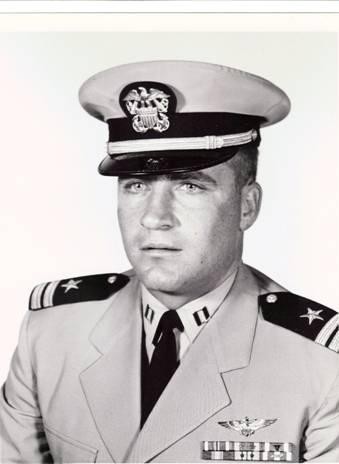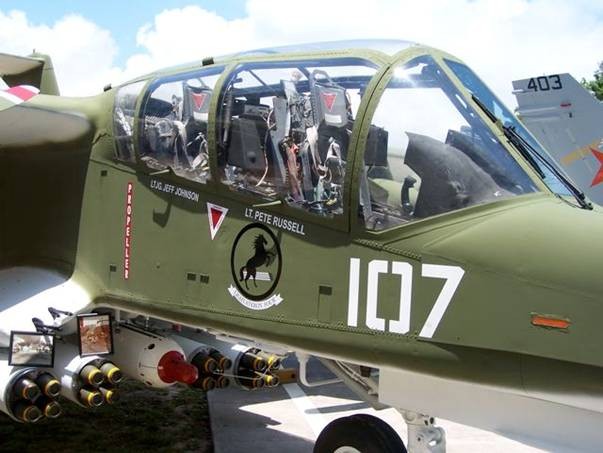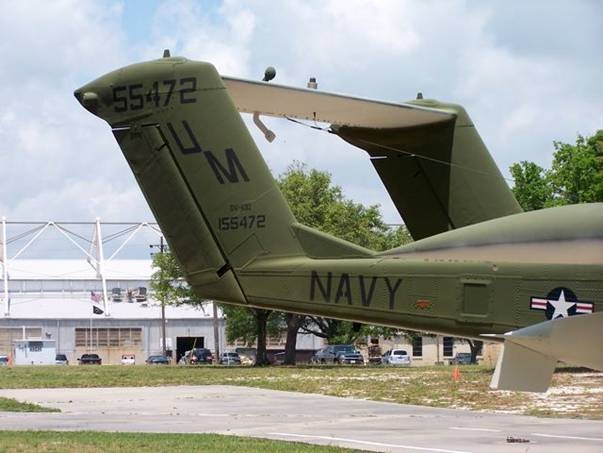Roll of Honor
Home | About | Campus Tour | Help Us
Peter Fransson Russell
- School: Columbia College
- Class Year: 1962
- War: Vietnam War
- Date of Death: May 23, 1969
Lieutenant Peter Fransson Russell, pilot, U.S. Navy, died at age 29 on May 23, 1969, at Kien Giang, South Vietnam. His body was recovered.

 Plane in which Pete Russell was killed, now at the Naval Aviation Museum in Florida.
Plane in which Pete Russell was killed, now at the Naval Aviation Museum in Florida.
 Plane in which Pete Russell was killed, now at the Naval Aviation Museum in Florida.
Plane in which Pete Russell was killed, now at the Naval Aviation Museum in Florida.
Tributes
In Memoriam: Peter F. Russell, Lieutenant, U.S. Navy, Naval Aviator March 12, 1940, Hartford, CT – May 23, 1969, Republic of Vietnam LT. Peter F. Russell, naval aviator, a member of the Mount Hermon class of 1958, attended Columbia College, class of 1962, on the Holloway plan, graduated and was commissioned an Ensign in June 1962. He was killed in action in the Republic of Vietnam on May 23rd, 1969 while he was coming to the aid of two navy patrol boats (PBRs, aka Swift boats) caught in an ambush. Flying an OV-10A Bronco with Light Attack Squadron 4 (VAL-4), Black Ponies, a lightly armed, lightly armored, highly maneuverable, twin turboprop aircraft, Pete and his wingman made repeated attacks against the enemy allowing the Swift boats to withdraw from the initial ambush point. Subsequently the boats again came under fire, and Pete, now out of ammunition ( “guns dry”) elected to make several more passes in an attempt to keep the enemy’s heads down and allow the Swift boats to escape beyond the range of enemy fire. During one of these “dry runs,” Pete was mortally wounded by a single round – the proverbial, random bullet navy pilots in Vietnam sardonically referred to as the “silver bee bee.” His co-pilot, who sits behind the pilot in the OV-10, recovered control of the aircraft pulling the aircraft out of a dive before it hit the water and returned it to base at Bien Thuy. Upon rolling to a stop on the runway, it was apparent that there was a single, caliber 30, bullet hole in the right side of the canopy and Pete was dead. Few might know that Pete had displayed great courage in another engagement that is well-known in naval aviation history. Despite having been a friend since our days at Mount Hermon and Columbia and having spent two or three nights together doing the town in San Diego in November and December 1968, Pete never mentioned a word of it to me. Two A-I Skyraiders, a single-pilot, propeller-driven, attack plane designed in 1945 with a payload equal to a B-17, were jumped by four MIG-17 jet fighters over North Vietnam on October 9th, 1966. A second section of Skyraiders led by Lt. Peter F. Russell joined the engagement. The outcome: one MIG -17 destroyed, one probably destroyed, and one damaged. All four Skyraiders returned safely to their aircraft carrier in the Gulf of Tonkin. The four Skyraiders from Attack Squadron 176, The Thunderbolts, launched from USS INTREPID, CVA-11, as RESCAP (rescue combat air patrol) to find, protect and rescue a downed pilot in North Vietnam. Approaching the shoreline, Pete Russell and his wingman detached to join with a rescue helicopter and to escort it while the two other aircraft proceeded inland to the search area. After flying through heavy anti-aircraft fire for several minutes, one of the lead pilots observed tracer fire coming “down” from above rather than coming up from the ground, and immediately became aware that they were being attacked by four MIG -17s. Upon hearing, “Thunderbolt,” the radio code word for MIG alert, Pete and his wingman arranged for the safety of the helicopter and joined the air battle several minutes later. Pete immediately engaged one MIG and then a second with 20mm gunfire, possibly damaging one, while his wingman shot down a MIG on his first pass. Thus four navy propeller-driven, attack aircraft defeated four jet fighters. A whole life is often symbolized by a small humble dash on a headstone that separates the date of birth from the date of death. None would mean more than the dash on Peter Russell’s headstone. No man hath greater love for his fellow man than he who would lay down his life for his brother. I admired Peter Russell in life as in death at Mount Hermon, at Columbia, and in the U.S. Navy. That he demonstrated incredible bravery is fact. That he was undoubtedly modest comes without surprise though his exceptional degree of modesty was a discovery to me. That he exhibited extraordinary courage coming to the aid of his countrymen when under attack by superior forces on at least two occasions is self-evident. He was also very generous, very often quite humorous, perpetually good-natured, and a friend who was an authentic human being.
- Frank Partel
MY REMEMBRANCES OF PETER F. RUSSELL Pete and I played on the Ridgewood High School, Ridgewood, N.J. football team as "new" seniors. We were both newcomers to the school in September 1957. We quickly became buddies as well as teammates. We double-dated with various girls, rode in his Volkswagen "Bug," and we visited each other's homes etc. Immediately after our high school graduation in June 1958 we shared an apartment for one week, along with about 4 other RHS classmates, at the shore near Tom's River, N.J. That fall we went on to study at Columbia University in New York, N.Y. There we both became members (midshipmen) in the Naval ROTC program as part of our studies and extra-curricular activities.One summer, while in Columbia, I visited Pete and his family at their vacation home in Maine. I quickly learned that, even on a hot August afternoon, the water in the Maine bays and ponds was far, far too cold for swimming. When Pete graduated from Columbia in June 1962 he went on to earn his wings as a U.S. Naval Aviator. Then he eventually went to Viet Nam where he was killed by the enemy while flying his OV-10 Bronco. Pete gave his life for his country, and I am very proud that I was a close friend, classmate and teammate of Pete's. He was one of the finest people I have ever known. He was responsible, honorable, amiable, very mature for his age, and generally a great person to spend time with. He had a lot to offer his family, friends and country. I find it very sad that Pete never lived long enough to accomplish all that he could have done. He will always live in my memory. After more than 40 years since his death, I still miss him. Kurt G. Wenzing, Jr.
- Kurt Wenzing
A REMEMBRANCE Pete graduated from Columbia University in 1962 with a major in International Relations. He spoke fluent Russian and Chinese (Mandarin). He went directly into flight training, receiving his wings in 1963 as Naval Aviator #V-20873. He spent a short tour in Willie Fuds (WF-2) aircraft before transitioning to the A-1H (affectionately known as the SPAD or AD). Following two deployments in Spads, to Viet Nam aboard the Intrepid and to the Med aboard Saratoga, he went to VA-45 as an instrument instructor. He did not like jet aviation and longed for the propeller days. When the call came from his former skipper of VA-176 to form up VAL-4, Pete jumped at the chance. He was part of the nucleus that formed VAL-4 and then deployed to South Viet Nam in March 1969. Pete was an outstanding aviator and naval officer for his short seven years the Navy. His outstanding career was cut short when he was killed in action on 23 May 1969 while providing air cover to a riverine patrol in his OV-10 Bronco. Pete was attached to VAL-4 flying out of Binh Thuy at the time. He was the first aviator lost in VAL-4 during their almost three year deployment. On 19 October 1966 while flying an A-1H off the U.S.S. Intrepid as section leader of a flight of four VA-176 A1H's, Pete was credited with a possible MIG shootdown when four MIG's jumped first one section and the the other section of A-1H's. The final score was one confirmed, one probable and one possible MIG. Pete was a highly decorated young officer at the time of his death, having been awarded the Distinguished Flying Cross with gold star, Purple Heart (posthumous), Air Medal with numeral 9, Navy Commendation Medal with combat V, National Defense Service Medal with gold star, Viet Nam Service Medal with 4 bronze stars, Republic of Viet Nam Campaign Medal with 1960 device and Republic of Viet Nam MUC Gallantry Cross (I don't have any record of the Silver Star award though that might have come posthumously). He is sorely missed by his family especially his brother and comrade in arms, Cdr. Kenneth B. Russell, USN (Ret) and Ken's wife Tudy. Pete was responsible for their meeting, though he didn't live to see that meeting take place. Ken Russell Commander, USN (Ret) (Ken Russell is now also deceased. This tribute was supplied by Ken and Peter Russell's brother, Winslow Russell.)
- Winslow Russell
Is any of our information incorrect? You can submit corrections, additional photos, and/or tributes to uarchives@columbia.edu.
